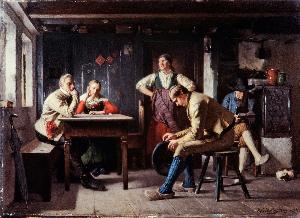Henrik Axel Kulle
Henrik Axel Kulle;Axel Kulle
Place: Lund
Born: 1846
Death: 1908
Biography:
Henrik Axel Kulle was a Swedish painter who specialized in genre scenes. Born on March 22, 1846, in Lund, Sweden, his father was a brewer and innkeeper. He had two brothers, Jakob and Sven, who were also artists.
Early Life and Education
Kulle was apprenticed to a local painter and later studied at the Royal Swedish Academy of Fine Arts from 1865 to 1872. During his time at the academy, he was exposed to traditional principles of painting, which would later influence his style.
Career
After completing his studies, Kulle returned to Lund and began selling his paintings to the local Art Society. In 1875, he moved to Düsseldorf, where he studied with Ferdinand Fagerlin, a Swedish-German genre painter. This experience introduced him to the Düsseldorf School style, which emphasized realism and attention to detail. In 1880, Kulle received a scholarship from the Dahlgrenska Foundation in Strömstad and moved to Paris. During his time in Paris, he developed a brighter color scheme and began painting en plein air. His works from this period show a significant shift towards modernism. Some of Kulle's notable paintings include The Church Council in Skåne, which was bought by the Nationalmuseum in 1877, and Skånsk fiskarflicka, which is now housed at the Göteborgs konstmuseum.
Teaching and Later Life
In 1885, Kulle was one of the signatories to a document drawn up by the group known as the Opponenterna, a group of artists who opposed the teaching methods at the Royal Academy. Despite this, in 1887, he was named a representative member of the Royal Academy and began teaching there. Kulle's students included Rikard Lindström, who remembered him as a man who always dressed formally and spoke little. Kulle died on February 27, 1908, in Stockholm, Sweden.
- Some of Kulle's works can be found at the Nationalmuseum in Stockholm.
- His paintings are also housed at the Göteborgs konstmuseum and the Kulturhistoriska museet in Lund.
- Kulle's biography can be found on Wikioo.org and on Wikipedia.
by Kulle can be seen at the Nationalmuseum, including Telegrammet 1876 and Den förlorade sonen 1881. His paintings are a testament to his skill in capturing the essence of everyday life and his ability to blend traditional principles with modern ideas.

